Audio Precision音频分析仪测试介绍
英国Precision Acoustics医用超声声输出测试系统

UMS3医用超声声场测试系统是世界知名的、专业从事超声水箱的PA公司生产,满足新的IEC62127-1, NEMA UD-3,或FDA 510(k)等标准的要求。
PA公司和全球权威的超声学实验室NPL保持良好的合作,PA公司的技术专家是IEC超声学标准制定的核心成员,能在第一时间给客户相应的解决方案。
UMS3 医用超声声场测试系统是目前市场上很新且功能全、高度集成且完善的超声实验仪器测试系统,可以用来测试医用理疗类超声、诊断类超声和HIFU类超声等超声设备的声场输出参数。
起源于20世纪中叶的超声诊断,是一种无放射性损伤的非侵人式的诊断方式,具有高分辨力、高灵敏度的特点。
超声诊断检测准确、使用灵活、成像快速、方便多次检查,可多方位切面检查,同时具有安全、快速、价廉的特点,在日常诊断中应用广泛,深受医生和患者的欢迎。
近些年来,随着经济的发展、人口的增加、社会老龄化程度的提高,以及公众健康意识的不断增强,超声医疗器械市场在中国一直保持着高速增长。
然而,在高速增长的背后,却不能忽视人们长久以来对于超声诊断设备安全性的忧虑。
超声波是一种机械波,是弹性介质中质点机械振动状态的传播过程,其实质是机械振动能量的传播过程。
在传播过程中,超声波会产生热效应和机械效应两种效应。
在人体组织传播的过程中,超声波的能量会不断被人体组织吸收转为热量,导致人体组织温度升高,尤其是在骨骼处的温升非常严重,这就是超声的热效应。
超声波又是机械振动能量的传播过程,由于超声波的特殊性质,致使在其人体传播过程中人体的细胞和组织发生激烈地机械运动,严重时将影响其功能、结构和生理功能。
医用超声设备的声辐射因为这两种效应,对人体组织,特别是发育中的胚胎细胞,已经被国内专家学者研究证明具有潜在的危害。
深圳市一测医疗测试技术有限公司是一家专注于医疗器械测试产品和技术的研发、销售与服务为一体的“国家高新技术企业”,我们拥有自主研发的国家发明专利技术并且代理了众多国外先进专业测试产品,如通用多组织超声体模、高频电刀分析仪、医用X光机测试仪、输液系统分析仪等。
AudioPrecision音频分析仪测试介绍演示课件

• AP1 Panel
AP introduction
AP introduction
• THD + N vs Level Curve
AP introduction
• Analyzer Panel
AP introduction
• Sweep Definitions Panel
AP introduction
AP introduction
• Crosstalk - Signals from one channel leaking into another channel. Normally, this happens between left and right stereo channels. - A generator drives one channel and this channel's output value is noted; meanwhile the other channel is set for zero volts. The measured channel left open. - Whatever signal is induced into the tested channel is measured at its output with an rms voltmeter and noted. A ratio is formed by dividing the unwanted signal by the above-noted output test value, and the answer expressed in dB.
- XLR plugs and sockets are used mostly in professional audio and video electronics cabling applications. Home audio and video electronics normally use RCA connectors.
音频分析仪使用方法说明书
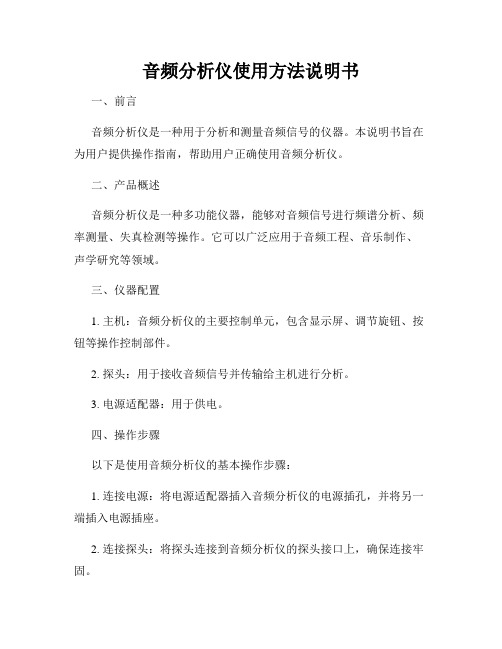
音频分析仪使用方法说明书一、前言音频分析仪是一种用于分析和测量音频信号的仪器。
本说明书旨在为用户提供操作指南,帮助用户正确使用音频分析仪。
二、产品概述音频分析仪是一种多功能仪器,能够对音频信号进行频谱分析、频率测量、失真检测等操作。
它可以广泛应用于音频工程、音乐制作、声学研究等领域。
三、仪器配置1. 主机:音频分析仪的主要控制单元,包含显示屏、调节旋钮、按钮等操作控制部件。
2. 探头:用于接收音频信号并传输给主机进行分析。
3. 电源适配器:用于供电。
四、操作步骤以下是使用音频分析仪的基本操作步骤:1. 连接电源:将电源适配器插入音频分析仪的电源插孔,并将另一端插入电源插座。
2. 连接探头:将探头连接到音频分析仪的探头接口上,确保连接牢固。
3. 打开电源:按下主机上的电源按钮,音频分析仪将开始启动。
4. 调节参数:使用主机上的调节旋钮,可以调节分析仪的参数,如频率范围、时间窗口等。
根据具体需求进行调整。
5. 选择分析模式:音频分析仪通常具有多种分析模式,如频谱分析、频率测量、失真检测等。
根据需要选择相应的模式。
6. 进行分析:根据选择的分析模式,将音频信号输入探头。
音频分析仪将对该信号进行相应的分析,并在显示屏上显示结果。
7. 结果解读:根据显示屏上的结果,用户可以对音频信号进行进一步的判断和分析。
注意观察频谱图、频率数值、失真程度等参数。
8. 关闭仪器:使用完毕后,先将音频信号断开,然后按下主机上的电源按钮,将音频分析仪关闭。
五、注意事项1. 请严格按照说明书的指引进行操作,避免任何不必要的损坏或故障。
2. 使用音频分析仪时,请确保工作环境安全,避免水、尘埃等物质对仪器造成影响。
3. 在操作过程中,避免过度调节参数,以免对音频信号产生误解。
4. 长时间使用音频分析仪时,注意及时散热,避免过热引起仪器故障。
六、维护保养1. 使用后,请及时将音频分析仪存放在干燥、通风的地方。
2. 定期清洁:使用干净、柔软的布轻轻擦拭音频分析仪的表面,避免使用有害化学物质。
AP音频分析仪--音频测试工程师的福音

AP音频分析仪--音频测试工程师的福音合肥汽车音响改装/音频测试时,工程师会遇到许多陌生、棘手的问题:⑴不稳定性和振动:产生的噪声常会在需要找到它的时候,暂时性消失;⑵接地回路:增加的噪声经常与交流电及被测设备的开关转换频率有关;⑶带外噪声:来自数模转换器和开关式功率放大器的输出信号会导致测量数据不准确。
针对以上问题,美国Audio Precision公司和上海美爵电子设备有限公司于12月8-9日在北京联合主办了Audio Precision音频分析仪专题技术讲座,使这些技术难题迎刃而解。
听取讲座的有中央人民广播电台、中国国际广播电台、北京电台,以及音频研究部门、中国传媒大学的音频专业人士和音频设备经销商。
美国AP公司应用工程师详细介绍了AP音频分析仪技术应用并进行现场解答。
讲座包括:数字音频接口方式、数字音频基础、连接技术、基本音频测量、多音频和遥控测试、自动化测试等内容。
目前Audio Precision公司有三款测试仪产品供用户选择:⑴最新旗舰产品AP 2700系列,支持单通道192kHz采样率,模拟/数字独立测试,低失真(-112dB)高带宽(500kHz);可通过视窗软件和APIB接口操作,也可通过标准的IEEE-488/GPIB接口控制;Dolby(AC-3)杜比数字信号。
⑵全新经济型A TS-2系列:适用于生产、维修和研发设计;快速测试频响、失真、噪声、相位和串音;频谱仪(FFT)、谐波分析、数字音频和接口分析。
⑶便携型P1系列和自动测试型A TS-1系列:2通道测试,集12种测试功能于一体;面板操作,简单容易;高亮屏显示,带IEEE-488/GPIB接口连接电脑。
Audio Precision公司是一家全球最大的音频测试仪器制造商,总部在美国,其主要产品为2700系列、A TS-2系列和P1系列;加上以前的System One、System Two系列的音频分析仪,目前在全球有超过1万套的用量。
关于音频分析仪的概述介绍
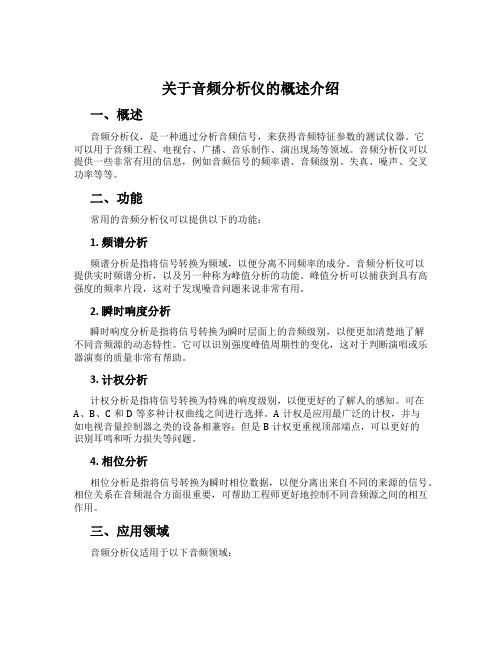
关于音频分析仪的概述介绍一、概述音频分析仪,是一种通过分析音频信号,来获得音频特征参数的测试仪器。
它可以用于音频工程、电视台、广播、音乐制作、演出现场等领域。
音频分析仪可以提供一些非常有用的信息,例如音频信号的频率谱、音频级别、失真、噪声、交叉功率等等。
二、功能常用的音频分析仪可以提供以下的功能:1. 频谱分析频谱分析是指将信号转换为频域,以便分离不同频率的成分。
音频分析仪可以提供实时频谱分析,以及另一种称为峰值分析的功能。
峰值分析可以捕获到具有高强度的频率片段,这对于发现噪音问题来说非常有用。
2. 瞬时响度分析瞬时响度分析是指将信号转换为瞬时层面上的音频级别,以便更加清楚地了解不同音频源的动态特性。
它可以识别强度峰值周期性的变化,这对于判断演唱或乐器演奏的质量非常有帮助。
3. 计权分析计权分析是指将信号转换为特殊的响度级别,以便更好的了解人的感知。
可在A、B、C和D等多种计权曲线之间进行选择。
A计权是应用最广泛的计权,并与如电视音量控制器之类的设备相兼容;但是B计权更重视顶部端点,可以更好的识别耳鸣和听力损失等问题。
4. 相位分析相位分析是指将信号转换为瞬时相位数据,以便分离出来自不同的来源的信号。
相位关系在音频混合方面很重要,可帮助工程师更好地控制不同音频源之间的相互作用。
三、应用领域音频分析仪适用于以下音频领域:1. 音频工程音频工程师常使用音频分析仪来测试、分类、比较和评估音频信号以及音响系统。
音频分析仪可用于作为声音压力级检测器和空气粒子振动检测器等多用途的测试工具。
2. 广播和电视在广播和电视领域中,音频分析仪可以帮助工作人员检查音频水平、频率响应、相位关系和失真等问题,以便更好的控制音频质量。
3. 音乐制作音频分析仪可以帮助音乐制作人员确定音乐的和谐性,并精确定位问题和提高声音质量。
它还可以帮助调整混响、削减和压缩等音效。
4. 演出现场音频分析仪也可以用于现场演出。
可以帮助音乐家检查他们的演唱、制作、混音和后期制作的质量。
Audio Precision及音频测量介绍20090702解析
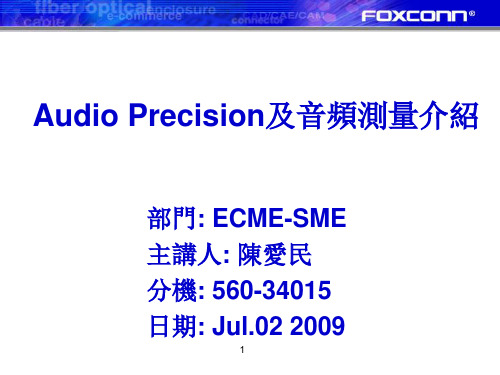
SYS-2700 系列
SYS-2700系列是一部和電腦連接工作的多功能音頻綜合測 試儀器。具備以下特點: 真正的雙領域(Dual Domain)模擬/數碼處理; 獨立的高精密度模擬信號源和分析儀,完全和數碼信號處理 器(DSP)分開,避免了互相干擾和對高保真的苛刻要求; 最新AP2700控制軟件(APWIN兼容)能在Win98或XP下運 作; 通過程序編制,完成多功能自動檢測、圖像曲線顯示、FFT 頻譜分析、多音頻測試(Multitone),MLS信號測試和實時 控制等等。
3.5mm立體聲接口(續)
藍色:音頻輸入端口,可將MP3、錄 音機、音響等的音頻輸出端通過雙頭 3.5mm的音頻綫連接到電腦,通過電 腦再進行處理或者錄製。 綠色:音頻輸出端口,用于連接耳機 或2.0、2.1音箱。 粉色:麥克風端口,用于連接到麥克 風。 黑色:後置環繞喇叭接頭,在四聲道/ 六聲道/八聲道音效設置下,用于可以 連接後置環繞喇叭。 橙色:中置/重低音喇叭接頭,在六聲 道/八聲道音效設置下,用于可以連接 中置/重低音喇叭。 灰色:側邊環繞喇叭接頭,在八聲道 音效設置下,用于可以連接側邊環繞 5 喇叭。
Audio Precision及音頻測量介紹
部門: ECME-SME 主講人: 陳愛民 分機: 560-34015 日期: Jul.02 2009
1
内容大綱
音頻接口的類型
Audio Precision基本知識介紹 PC音頻測試的重要參數 SME的音頻測試能力
2
3.5mm立體聲接口
3.5mm立體聲接口又 叫做小三芯接口,這 是我們目前看到的最 主要的接口,絕大部 分消費類聲卡(包括 板載聲卡)都在使用 這類接口。右圖為小 三芯接口的公頭。
RCA模擬音頻接口
AudioPrecision和音频测量介绍专题培训课件

3.5mm立體聲接口(續)
3.5mm接口提供了立體聲的輸入輸出功
能,因此一般來說支持5.1的聲卡(6聲
道)或音箱來說,就需要3個3.5mm立
體聲接口來接駁模擬音箱(3×2聲道=6
聲道);7.1聲卡或音箱就需要4個
3.5mm立體聲接口(4×2聲道=8聲道),
以此類推。爲了適應不同的設備需求,
同類的接口目前能看到的有三個尺寸規
4
3.5mm接頭 2.5mm接頭
3.5mm立體聲接口(續)
藍色:音頻輸入端口,可將MP3、錄
音機、音響等的音頻輸出端通過雙頭
3.5mm的音頻綫連接到電腦,通過電
腦再進行處理或者錄製。
綠色:音頻輸出端口,用于連接耳機
或2.0、2.1音箱。
粉色:麥克風端口,用于連接到麥克
風。
黑色:後置環繞喇叭接頭,在四聲道/
2722A:2通道 雙模擬/數碼領域,帶DSP功能音頻分析儀 (美國杜比公司測試Digital Dolby/AC-3的標準型號)
2720A: 2通道 數碼音頻分析儀(不帶模擬功能) 2712A: 2通道 模擬音頻分析儀帶DSP功能 2702A: 2通道 模擬音頻分析儀 (注A: 帶APIB接口和AP2700控制軟件;介面卡:PCI或PCMIA
12
内容大綱
音頻接口的類型
Audio Precision基本知識介紹 PC音頻測試的重要參數 SME的音頻測試能力
13
AP-2722 的幾種音頻接口
XLR接口
BNC接口
S/PDIF 光
纖接口
14
AP公司及產品系列
Audio Precision公司是全球最大的音頻測試儀器制造商,創 立于1984年,總部位于美國俄勒岡州,現主要產品為APx500 系列、2700系列、ATS-S2和P1系列。其中APx500、2700和 ATS-S2系列屬于電腦控制測試系統,而P1系列屬于便攜式的 測試儀器。首先來看一下應用比較普遍的2700系列。它包括 四種型號可供選擇:
audio precision使用手册
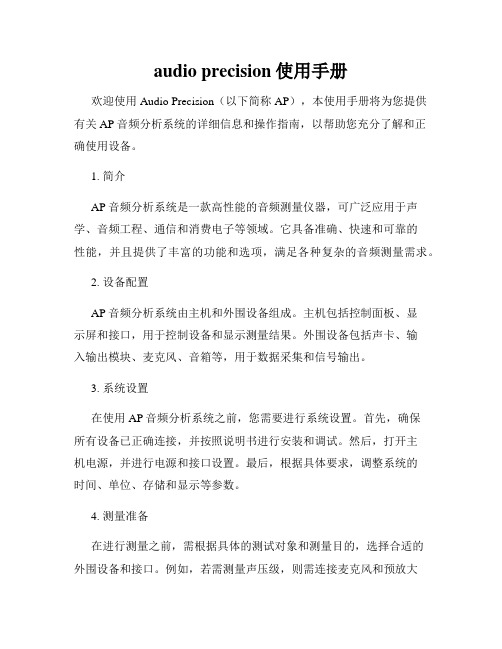
audio precision使用手册欢迎使用Audio Precision(以下简称AP),本使用手册将为您提供有关AP音频分析系统的详细信息和操作指南,以帮助您充分了解和正确使用设备。
1. 简介AP音频分析系统是一款高性能的音频测量仪器,可广泛应用于声学、音频工程、通信和消费电子等领域。
它具备准确、快速和可靠的性能,并且提供了丰富的功能和选项,满足各种复杂的音频测量需求。
2. 设备配置AP音频分析系统由主机和外围设备组成。
主机包括控制面板、显示屏和接口,用于控制设备和显示测量结果。
外围设备包括声卡、输入输出模块、麦克风、音箱等,用于数据采集和信号输出。
3. 系统设置在使用AP音频分析系统之前,您需要进行系统设置。
首先,确保所有设备已正确连接,并按照说明书进行安装和调试。
然后,打开主机电源,并进行电源和接口设置。
最后,根据具体要求,调整系统的时间、单位、存储和显示等参数。
4. 测量准备在进行测量之前,需根据具体的测试对象和测量目的,选择合适的外围设备和接口。
例如,若需测量声压级,则需连接麦克风和预放大器;若需测量频率响应,则需连接音箱和功率放大器。
此外,还需进行校准和校验,以确保测量结果的准确性和可靠性。
5. 测量操作AP音频分析系统提供了丰富的测量功能和选项。
在进行测量之前,您可以选择相应的测量类型(如频率响应、失真分析、噪声分析等),并设置相关参数(如测量范围、分辨率、加窗函数等)。
然后,通过控制面板或软件界面,启动和停止测量,并实时显示和记录测量结果。
6. 数据分析AP音频分析系统不仅能够进行实时测量,还可以对已采集的数据进行深入分析。
通过内置的分析工具和算法,您可以进行数据处理、曲线拟合、谱图绘制等操作,从而获取更详尽和全面的分析结果。
此外,还可以将数据导出为图像、报告或其他格式,以便于后续处理和分享。
7. 故障排除在使用AP音频分析系统过程中,可能会遇到一些问题和故障。
一般情况下,您可以参考用户手册或在线帮助文档,了解常见问题的解决方法。
Audio Precision音频分析仪测试介绍
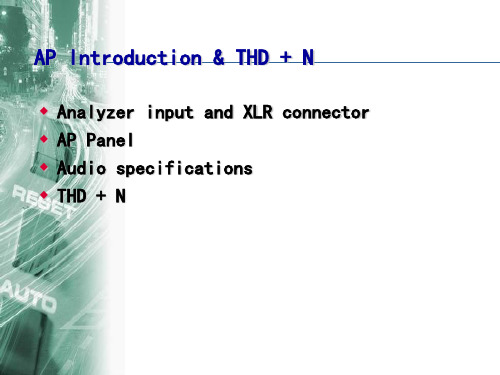
AP introduction
Crosstalk - Signals from one channel leaking into another channel. Normally, this happens between left and right stereo channels. - A generator drives one channel and this channel's output value is noted; meanwhile the other channel is set for zero volts. The measured channel left open. - Whatever signal is induced into the tested channel is measured at its output with an rms voltmeter and noted. A ratio is formed by dividing the unwanted signal by the above-noted output test value, and the answer expressed in dB.
AP Introduction & THD + N
Analyzer input and XLR connector AP Panel Audio specifications THD + N
AP introduction
Analyzer input cable connection
- Single ended output (MP3 headphone)
AP introduction
Signal to Noise Ratio - Signal to noise ratio, as a relative measurement, must be made with reference to a specific output amplitude from the device under test. - The rated output amplitude must be calibrated as the 0 dBr reference of the analyzer. Then the residual output amplitude (noise) is measured and expressed in dB relative to the reference.
AUDIO 纯音扬声器测试系统 说明书

纯音扬声器测试系统一个现代化先进测试系统的主要特点是速度快,操作简单,可重现与自动化。
纯音扬声器测试系统完全符合这些特点。
包含了百分之百与人耳相关的独特异音检测分析功能,以客观、可靠与可重复的客观分析取代了传统主观的人耳听音检测。
纯音扬声器测试系统是基于 RT -2M 快速音频分析仪,和以计算机为平台运作的 RT -Speaker 扬声器测试软件构成。
它是用于元件单体,半成品组装加工或成品测试的最佳测试系统。
主要特色• 速度快典型的测试周期时间为 1.5 - 2.5 秒。
• 精确RT -2M 快速音频分析仪基于可靠的科学技术,提供精确与一致的测试结果。
• 异音检测功能独特与优越的异音检测功能,百分之百与人耳相关,以客观的检测取代了传统主观的听音测试。
• 噪声排除采用特殊技术,即使在有噪声的生产环境下仍有良好的性能。
• 自动化产线自动化支持PLC 接口、条码或数据记录(例如 Cpk,Ppk )。
•产品多通道操作能不经人工操作,依顺序自动完成两个或多个待测产品的扬声器测试。
介绍电声换能器在生产时不可避免会有较高的不良率,因此在生产音频相关产品时,越早的阶段筛选出不良的电声换能器,可以提高成品总良率与降低报废材料,同时优化生产产品的品质。
RT-2M快速音频分析仪与 RT-Speaker 生产测试软件,完全符合产品品质控制与生产快速测试要求的纯音扬声器测试系统。
RT-2M 快速双通道音频分析仪测试功能:• 频率响应• 声压级 dBSPL• 完全与人耳相关一致的异音分析• 阻抗响应与共振频率• 失真,总谐波失真THD, THD+N, 2nd 到 5th 谐波失真(D2,D3,D4,D5), 3rd到 5th 谐波失真 (D3+D4+D5)• 扬声器极性• Thiele/Small 参数• 直流电阻纯音检测能检测出扬声器受话器等电声换能器,任何生产制程瑕疵所造成的异音,例如漏气,音圈不正,擦圈,松散微粒,碰线等等 ...简单与直观的操作纯音扬声器测试系统可以在数分钟以内设置组建完成。
AUDIO国标测试SOP
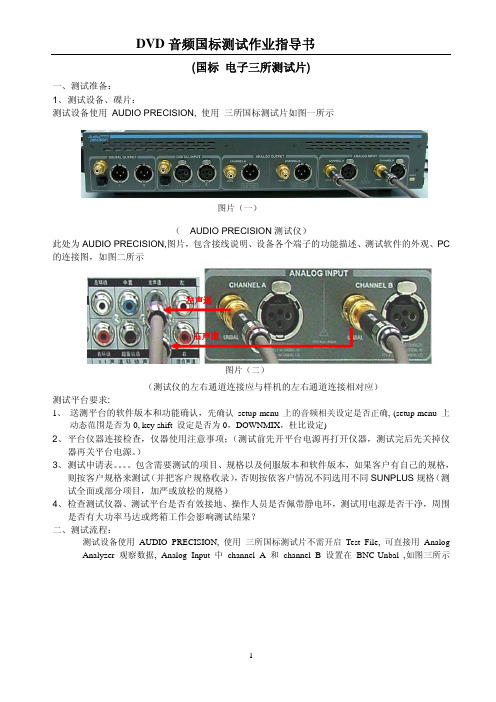
3. 音频信噪比 技术要求 ≧90dB 测试讯号: 立体声音频----音频信噪比----1kHz, 0dB;0 电平 Function Reading 设定:Amplitude Filter 设定: A-weighting 和 20kHz apogee low pass filter DVD Player speaker 设定: Large 分别播放测试 1kHz, 0dB;0 电平信号, 再由 function reading 里, 选取 A channel 和 B channel
响
应
16KHz
18KHz
dB ±3
±2
±1
dB ±3
±2
±1
dB ±3
±2
±1
dB ±3
±2
±1
dB ±3
±2
±120KHzdB源自±3±2±13
音 频 信 A 计权 噪比 不计权
4 失真加 20K LPF
噪声 (1KHz)
A 计权
5 动态范围(1KHz)
dB ≥90 ≥95 ≥100 dB ≤-65 ≤-70 ≤-75 dB ≥80 ≥85 ≥90
DVD 音频国标测试作业指导书
(国标 电子三所测试片)
一、测试准备: 1、 测试设备、碟片: 测试设备使用 AUDIO PRECISION, 使用 三所国标测试片如图一所示
图片(一) ( AUDIO PRECISION 测试仪) 此处为 AUDIO PRECISION,图片,包含接线说明、设备各个端子的功能描述、测试软件的外观、PC 的连接图,如图二所示
左声道
右声道
图片(二) (测试仪的左右通道连接应与样机的左右通道连接相对应) 测试平台要求: 1、 送测平台的软件版本和功能确认,先确认 setup menu 上的音频相关设定是否正确, (setup menu 上 动态范围是否为 0, key shift 设定是否为 0,DOWNMIX,杜比设定) 2、 平台仪器连接检查,仪器使用注意事项;(测试前先开平台电源再打开仪器,测试完后先关掉仪 器再关平台电源。) 3、 测试申请表。。。。包含需要测试的项目、规格以及伺服版本和软件版本,如果客户有自己的规格, 则按客户规格来测试(并把客户规格收录),否则按依客户情况不同选用不同 SUNPLUS 规格(测 试全面或部分项目,加严或放松的规格) 4、 检查测试仪器、测试平台是否有效接地、操作人员是否佩带静电环,测试用电源是否干净,周围 是否有大功率马达或烤箱工作会影响测试结果? 二、测试流程: 测试设备使用 AUDIO PRECISION, 使用 三所国标测试片不需开启 Test File, 可直接用 Analog Analyzer 观察数据, Analog Input 中 channel A 和 channel B 设置在 BNC-Unbal ,如图三所示
audio precision使用手册

audio precision使用手册Audio Precision是一款功能强大的音频分析仪,用于测量音频设备的性能和指标。
以下是使用Audio Precision的分析仪的一些关键步骤:1.准备工作:首先,您需要准备好音频分析仪和相应的配件,包括信号线、耳机放大器、校准标准器等。
确保分析仪已经正确连接并开启。
2.校准分析仪:在使用Audio Precision分析仪之前,您需要进行校准。
这可以确保分析仪的准确性和可靠性。
您可以使用校准标准器,按照分析仪的指示进行校准操作。
3.设置测量参数:根据您的测量需求,您需要设置适当的测量参数。
这些参数包括音频频率范围、测量模式(如幅度、时间或频率响应等)、分辨率等。
确保您选择的参数与您的测量需求相匹配。
4.连接音频设备:将音频设备连接到音频分析仪上。
您可以使用信号线将音频设备连接到分析仪的输入端口。
确保连接牢固,以避免信号损失或干扰。
5.开始测量:在分析仪上选择适当的测量模式,并开始进行测量。
分析仪将自动读取并记录音频设备的性能指标。
您可以在分析仪的显示屏上查看实时测量结果,并保存测量数据以供后续分析。
6.分析测量结果:一旦您完成了测量,您可以分析测量结果以确定音频设备的性能和质量。
Audio Precision分析仪提供了多种分析工具,如频谱分析、波形分析等,以帮助您更好地理解测量结果。
7.故障排除:如果您遇到任何问题或测量结果异常,您可以进行故障排除。
首先检查连接是否牢固,然后检查分析仪的设置和校准状态。
如果问题仍然存在,您可以查阅Audio Precision的文档或联系技术支持以获取更多帮助。
总之,使用Audio Precision的分析仪需要一些基本的准备工作和设置步骤。
一旦您熟悉了这些步骤,您就可以轻松地使用这款强大的音频分析工具来测量音频设备的性能和指标。
AP & Sound Check测试系统简介
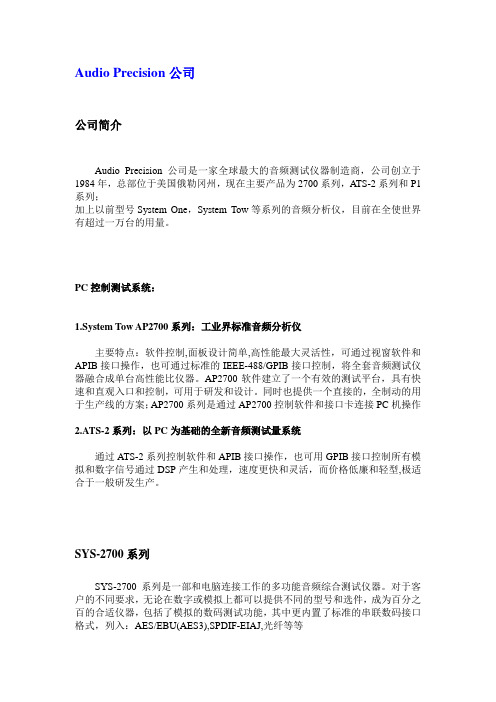
Audio Precision公司公司简介Audio Precision公司是一家全球最大的音频测试仪器制造商,公司创立于1984年,总部位于美国俄勒冈州,现在主要产品为2700系列,ATS-2系列和P1系列;加上以前型号System One,System Tow等系列的音频分析仪,目前在全使世界有超过一万台的用量。
PC控制测试系统:1.System Tow AP2700系列:工业界标准音频分析仪主要特点:软件控制,面板设计简单,高性能最大灵活性,可通过视窗软件和APIB接口操作,也可通过标准的IEEE-488/GPIB接口控制,将全套音频测试仪器融合成单台高性能比仪器。
AP2700软件建立了一个有效的测试平台,具有快速和直观入口和控制,可用于研发和设计。
同时也提供一个直接的,全制动的用于生产线的方案;AP2700系列是通过AP2700控制软件和接口卡连接PC机操作2.ATS-2系列:以PC为基础的全新音频测试量系统通过ATS-2系列控制软件和APIB接口操作,也可用GPIB接口控制所有模拟和数字信号通过DSP产生和处理,速度更快和灵活,而价格低廉和轻型,极适合于一般研发生产。
SYS-2700系列SYS-2700系列是一部和电脑连接工作的多功能音频综合测试仪器。
对于客户的不同要求,无论在数字或模拟上都可以提供不同的型号和选件,成为百分之百的合适仪器,包括了模拟的数码测试功能,其中更内置了标准的串联数码接口格式,列入:AES/EBU(AES3),SPDIF-EIAJ,光纤等等SYS-2700系列是Audio Precision延续于工业界标准System One/System Tow 系列,而在2003年底推出的最新旗舰产品,具备以下特点:真正的双领域(Dual Domain)模拟/数字处理:独立的高精度模拟信号源和分析仪,完全和数字信号处理器(DSP)分开,避免了相互干扰和对高保真的苛刻要求。
最新的AP-2700控制软件(APWIN兼容)能在WINDOW98、XP、Win7下运作,同时通过程序编制,完成多功能自动检测,图像曲线显示,FFT频谱分析,多音测试(Multitone),MSL型号测试和实时分析控制等模拟分析:能测试电平(2通道),电平比率,频率,相位,THD+N失真(小于-112 dB)互调失真,噪声,带通幅度,串音干扰,抖晃。
Audio Precision及音频测量介绍
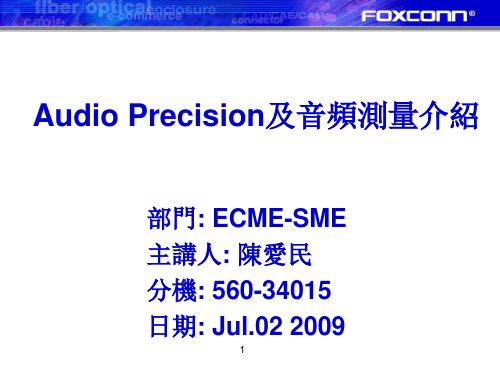
部門: ECME-SME 主講人: 陳愛民 分機: 560-34015 日期: Jul.02 2009
1
内容大綱
音頻接口的類型
Audio Precision基本知識介紹 PC音頻測試的重要參數 SME的音頻測試能力
2
3.5mm立體聲接口
3.5mm立體聲接口又 叫做小三芯接口,這 是我們目前看到的最 主要的接口,絕大部 分消費類聲卡(包括 板載聲卡)都在使用 這類接口。右圖為小 三芯接口的公頭。
9
S/PDIF接口
S/PDIF(Sony/Philips Digital Interface,索尼 和飛利浦數字接口)是由SONY公司與 PHILIPS公司聯合制定的一種數字音頻輸出接 口。S/PDIF接口是一種標準,同軸數字接口和 光纖接口都屬于S/PDIF接口的範疇。
10
S/PDIF接口-數字同軸接口
RCA模擬音頻接口
RCA接頭就是常說的蓮花 頭,利用RCA綫纜傳輸模 擬信號是目前最普遍的音 頻連接方式。每一根RCA 綫纜負責傳輸一個聲道的 音頻信號,所以立體聲信 號,需要使用一對綫纜。 對于多聲道系統,就要根 據實際的聲道數量配以相 同數量的綫纜。立體聲 RCA音頻接口,一般將右 聲道用紅色標注,左聲道 則用藍色或者白色標注。
7
平衡模擬音頻接口(續)
XLR接口 大三芯插头
帶有XLR和RCA同軸接頭的音箱
8
TRS平衡接口
TRS平衡接口能提供平衡輸入/ 輸出。TRS的含義是Tip (signal)、Ring(signal)、 Sleeve(ground)。分別代表 了該接口的3個接觸點(其實與 6.22mm接口一樣)。 TRS平 衡接口除了具有和6.22mm接口 一樣的優點——耐磨損外,還 具有平衡口擁有的高信噪比, 抗干擾能力强等特點。對于一 個真正的TRS平衡接口來說, 其成本將是非平衡的2倍多。因 此采用TRS平衡接口的設備一 般是高檔設備,只有在2000元 以上的專業卡上才可以看到。
Audio-Precision音频分析仪测试介绍PPT

value, and the answer expressed in dB.
11
AP introduction
• Harmonic Distortion Concepts - Harmonic distortion may be measured and expressed as total harmonic distortion (THD), or as total harmonic distortion plus noise (THD + N). - THD is the distortion that occurs on harmonics of the original signal. Noise is the more random, uncorrelated distortion. - In all cases, stimulus from a very pure sinewave generator is fed to the input of device under test. The generator must have significantly lower distortions than that of device.
AudioPrecision及音频测量介绍
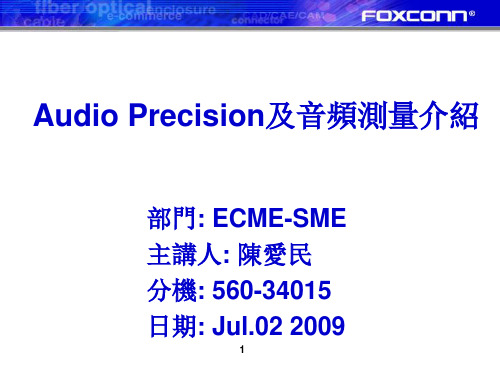
内容大綱
音頻接口的類型
Audio Precision基本知識介紹 PC音頻測試的重要參數 SME的音頻測試能力
20
A-D-PC的測試參數
• Full Scale Input Voltage (FSIV滿刻度輸入電壓) • Sample Frequency Accuracy (SFA採樣頻率精准度) • Frequency Response (FR頻率響應) • Total Harmonic Distortion (THD+N縂諧波失真+噪
6
平衡模擬音頻接口
與RCA模擬音頻綫纜直接傳輸聲音的方式完全不 同,平衡模擬音頻(Balanced Analog Audio)接 口使用兩個通道分別傳送信號相同而相位相反的 信號。接收端設備將這兩組信號相减,干擾信號 就被抵消掉,從而獲得高質量的模擬信號。平衡 模擬音頻通常采用XLR接口和大三芯接口。XLR 俗稱卡儂頭,有三針插頭和鎖定裝置組成。由于 采用了鎖定裝置,XLR連接相當牢靠。大三芯接 口則采用直徑爲6.35毫米的插頭,其優點是耐磨 損,適合反復插拔。平衡模擬音頻連接主要出現 在高級模擬音響器材或專業音頻設備上。
平坦度:模擬域20Hz-20kHz 典型±0.03dB 低抖動: 700Hz-100kHz 帶寬小于等于600ps; 50Hz-
100kHz 小于等于1.0ns FFT采樣:多至4兆樣本(87秒在48kHz采樣時)
SYS-2700系列選件 杜比數字信號源選件 編程串連界面匹配器 各種標準濾波器—加權、高通、低通、帶通、帶阻等 各種電纜線等等
9
S/PDIF接口
S/PDIF(Sony/Philips Digital Interface,索尼 和飛利浦數字接口)是由SONY公司與 PHILIPS公司聯合制定的一種數字音頻輸出接 口。S/PDIF接口是一種標準,同軸數字接口和 光纖接口都屬于S/PDIF接口的範疇。
音频分析仪介绍

音频分析仪介绍音频分析仪包括一个测试电路和两个输入电路,可以同时输入两个信号,通过独立的选择器进行各种测试。
它可以用于以下几种测试:1.Frequency Measurement2.AC level Measurement3.Relative Measurement4.W Display5.Total distortion rate Measurement(THD+N)6.Harmoic Analysis(THD)7.S/N Ratio Measurement8.SINAD Measurement9.Ration Measurement(L/R,R/L)(频道分离度或频道串扰)10.DC Leleve Measurement下面是对其各个功能块的介绍(一)系统的设置(Menu SYSTEM)系统的设置功能主要是针对外部接口的,如进行外部的存储拷贝,打印等操作.其外部的端口如图所示:由图可以看出,外部有一个32位的EXT CONTROL I/O口和一个GP-IB 接口.图中的GEN OUTPUT AC INPUT DC INPUT ,在NO Loading 时,接在模拟地那一端,在有负载时,接在数字地那一端。
在进行音频测试时,若无需用要其外部的功能,则系统无需做设置,对测试的结果没有影响。
系统各个项目的具体含义如下表所示:SYSTEM 系统的设置Meu1 LCD的调整INTEN LCD亮度的调整(0~9)CTRS LCD对比度的调整(0~9)VER 版本号,年月Meu2 EXT I/O口的设置PT.1 指外部EXT I/O口P1.0~P1.7CONT 作为输出口M.RCL Memory RecallingPRINT 作为打印输出口PT.2 指外部EXT I/O口P2.0~P2.7CONT 作为输出口D.READ 作为输入口PRINT 打印模式的设置MODE0 都不打印MODE1 当测量的值超过限制的范围时打印MODE2 当测量的值落在特定的存储地址时打印MODE3当测量的值落在特定的存储地址且超过限制的范围时打印MODE4 所有的存储测量值均依次打印Meu3 测量数据存储的设置GP 存储组的设置(从0~9)ST 存储的起始地址设置(00~99)END 存储的终止地址设置(00~99)Meu4 存储数据的内部拷贝和交换(地址段A--地址段B)S.ST 要拷贝或交换数据起始地址A的设置(00~99)S.END 要拷贝或交换数据终止地址A的设置(00~99)D.ST要拷贝或交换数据起始地址B的设置(00~99),最终地址默认为99COPY 执行拷贝操作SWAP 执行SWAP操作Meu5 通过GP-IB 接口存储到其他设备ST 存储到其他设备数据起始地址的设置(00~99)END 存储到其他设备数据终止地址的设置(00~99)ADRS 对GP-IB端口的选择(00~31)ADD 对端口进行增加CLR 清楚DUMP 执行操作Meu6 存储数据的打印ST 打印起始地址设置(00~99)END 打印终止地址设置(00~99)LIST 执行打印操作Meu7 同步设置(二)Front Panel 的界面(三)测试时各个项目的功能介绍1.要选中上一排的测试项目,直接按一下就可以了。
APSoundCheck测试系统简介

APSoundCheck测试系统简介Audio Precision公司公司简介Audio Precision公司是一家全球最大的音频测试仪器制造商,公司创立于1984年,总部位于美国俄勒冈州,现在主要产品为2700系列,ATS-2系列和P1系列;加上以前型号System One,System T ow等系列的音频分析仪,目前在全使世界有超过一万台的用量。
PC控制测试系统:1.System Tow AP2700系列:工业界标准音频分析仪主要特点:软件控制,面板设计简单,高性能最大灵活性,可通过视窗软件和APIB接口操作,也可通过标准的IEEE-488/GPIB接口控制,将全套音频测试仪器融合成单台高性能比仪器。
AP2700软件建立了一个有效的测试平台,具有快速和直观入口和控制,可用于研发和设计。
同时也提供一个直接的,全制动的用于生产线的方案;AP2700系列是通过AP2700控制软件和接口卡连接PC机操作2.ATS-2系列:以PC为基础的全新音频测试量系统通过ATS-2系列控制软件和APIB接口操作,也可用GPIB接口控制所有模拟和数字信号通过DSP产生和处理,速度更快和灵活,而价格低廉和轻型,极适合于一般研发生产。
SYS-2700系列SYS-2700系列是一部和电脑连接工作的多功能音频综合测试仪器。
对于客户的不同要求,无论在数字或模拟上都可以提供不同的型号和选件,成为百分之百的合适仪器,包括了模拟的数码测试功能,其中更内置了标准的串联数码接口格式,列入:AES/EBU(AES3),SPDIF-EIAJ,光纤等等SYS-2700系列是Audio Precision延续于工业界标准System One/System T ow 系列,而在2003年底推出的最新旗舰产品,具备以下特点:真正的双领域(Dual Domain)模拟/数字处理:独立的高精度模拟信号源和分析仪,完全和数字信号处理器(DSP)分开,避免了相互干扰和对高保真的苛刻要求。
- 1、下载文档前请自行甄别文档内容的完整性,平台不提供额外的编辑、内容补充、找答案等附加服务。
- 2、"仅部分预览"的文档,不可在线预览部分如存在完整性等问题,可反馈申请退款(可完整预览的文档不适用该条件!)。
- 3、如文档侵犯您的权益,请联系客服反馈,我们会尽快为您处理(人工客服工作时间:9:00-18:30)。
资料仅供参考
AP introduction
• Harmonic Distortion Concepts - Harmonic distortion may be measured and expressed as total harmonic distortion (THD), or as total harmonic distortion plus noise (THD + N). - THD is the distortion that occurs on harmonics of the original signal. Noise is the more random, uncorrelated distortion. - In all cases, stimulus from a very pure sinewave generator is fed to the input of device under test. The generator must have significantly lower distortions than that of device.
资料仅供参考
AP introduction
• Harmonic Distortion Concepts - Level and THD+N The measured THD+N of a device will also vary with level and the frequency of the applied signal. Audio THD+N is typically measured and reported at a mid-range frequency (1 kHz or so) at the either the device's nominal operating level or at its maximum output level (MOL). - A THD+N versus frequency sweep or a THD+N versus amplitude sweeps will show how a DUT performs under varying stimulus.
THD + N
• Headphone output
资料仅供参考
THD + N
• Headphone output
资料仅供参考
THD + N
资料仅供参考
Thank you!
资n
• Signal to Noise Ratio - Signal to noise ratio, as a relative measurement, must be made with reference to a specific output amplitude from the device under test. - The rated output amplitude must be calibrated as the 0 dBr reference of the analyzer. Then the residual output amplitude (noise) is measured and expressed in dB relative to the reference.
资料仅供参考
AP introduction
• Crosstalk - Signals from one channel leaking into another channel. Normally, this happens between left and right stereo channels. - A generator drives one channel and this channel's output value is noted; meanwhile the other channel is set for zero volts. The measured channel left open. - Whatever signal is induced into the tested channel is measured at its output with an rms voltmeter and noted. A ratio is formed by dividing the unwanted signal by the abovenoted output test value, and the answer expressed in dB.
资料仅供参考
AP introduction
• Analyzer input cable connection - Single ended output (MP3 headphone) 2 – Signal, 3 – Ground. e.g., Channel A: 2 – Left output, 3 – Ground Channel B: 2 – Right output, 3 – Ground - Differential output (loudspeaker) 2 – Non-inverting signal, 3 – Inverting signal
资料仅供参考
AP introduction
• Harmonic Distortion Concepts - Bandwidth and THD+N The measured THD+N of a device will vary with the measurement bandwidth. You will almost always want to restrict the measurement bandwidth using high-pass and lowpass filters, and you must include the bandwidth used when you state the result. THD+N is typically measured and reported in a 20 Hz"20 kHz bandwidth.
• AP1 Panel
资料仅供参考
AP introduction
资料仅供参考
AP introduction
• THD + N vs Level Curve
• Analyzer Panel
资料仅供参考
AP introduction
资料仅供参考
AP introduction
• Sweep Definitions Panel
资料仅供参考
AP introduction
• Harmonic Distortion Concepts - THD refers to measurement methods which individually measure the amplitude of each significant harmonic in a narrow bandwidth, then combines them in root-mean-square fashion to produce a single number. - THD + N, refers to the measurement technique in which the fundamental component is removed by a bandreject (norch) filter and all remaining energy measured, including harmonics and noise.
资料仅供参考
AP introduction
• XLR Connector
资料仅供参考
AP introduction
• XLR Connector - In reference to its original manufacturer, James H. Cannon, founder of Cannon Electric in Los Angeles, California (now part of ITT Corporation), the connector is colloquially known as a cannon plug or cannon connector. - The most common is the 3-pin XLR3, used almost universally as a balanced audio connector for high quality microphones and connections between equipment. - XLR plugs and sockets are used mostly in professional audio and video electronics cabling applications. Home audio and video electronics normally use RCA connectors.
• Headphone output
资料仅供参考
THD + N
• THD + N vs Level
资料仅供参考
THD + N
• THD + N vs Level
资料仅供参考
THD + N
• Headphone output
资料仅供参考
THD + N
• Headphone output
资料仅供参考
资料仅供参考
AP introduction
• Frequency Response - Frequency Response measurements are made by stepping or sweeping a sine wave oscillator, at a fixed amplitude, across the spectrum of interest. - Usually stated in terms of dB variation from some reference midband frequency(e.g., 1KHz). - The test may be easily modified. The frequency range and direction of sweep can be changed from the 20 KHz ~ 20 Hz stored by entering new values for START and STOP under SWEEP (F9) DEFINITIONS panel.
